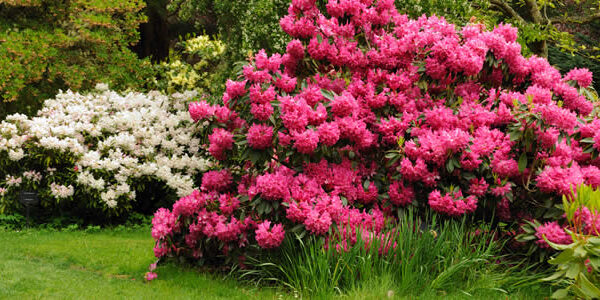Blooming Blossoms

With summer almost upon us, the trees are blooming and flowers are blossoming, all helped by the glorious weather we had at the start of spring.
It may seem a bit of a distant memory now, but those warm weeks around Easter meant that nature had the best head-start this year. For those that have fruit trees, expect a bumper crop! Personally, I love the spring – the return of life from a dormant winter is truly magical to me. It’s also the time when many shrubs go into flower so that they can dedicate the long days ahead to putting on new growth.
Plant focus – Rhododendrons and Azaleas
Out of all the spring flowering shrubs, it’s the Rhododendrons and Azaleas that steal the show. With their exotic flowers and wonderful scent, they have become a staple plant in any traditional English garden.
Their popularity grew when large private estates, such as Exbury, sponsored plant hunters to scour the Himalayas to enhance their collections. Nowadays, the Rhododendron species numbers the largest of all the acid-loving plants (Ericaceae), numbering about 1000 different species.
At Haskins it’s easy to choose the right Rhododendron or Azalea for your garden. We’ve split our Rhododendron collection into three main groups:
• Dwarfing – Tagged with a cream label, these are tough alpine varieties that mainly flower through April. Being alpine plants, they prefer moist, cooler conditions, so hot sunny positions are best avoided. These plants keep their small compact habit and look great in a rockery.
• Yakushimanum – Tagged with a pink label, these are the compact varieties suitable for pots and small borders. Typically flowering in May, these tough plants can handle slightly higher pH soils and grow up to 75-100cm (2.5-3ft) in 10 years.
• Hardy Hybrids– Tagged with a dark yellow or white label, these plants are ideal for hedging, screening or planting in borders. Flowering anytime from January to July, these larger varieties usually grow to 125-200cm (4-6ft) in 10 years.
Our Azalea collection is also split into two groups: the evergreens and the deciduous types:
• Evergreen Azaleas, sometimes known as Japanese Azaleas, are perfect for any size of garden, from a patio tub to large estate. They flower from April to May and generally grow to just under a meter (3ft) in 10 years, although some can get much larger.
• Deciduous Azaleas herald from Turkey, North America and Asiatic areas such as Japan and Taiwan. They lose their leaves over the winter and flower before they come into leaf the following spring. Their flowers are striking oranges and yellows and usually highly scented. They perform best in partial shade or in woodland edge situations. Once established, these are tough and fast growing plants that grow 125-150cm (4-5ft) in 10 years.
Both Rhododendrons and Azaleas are simple to look after so long as they are planted in either a compost specifically formulated for acid-loving plants, labelled ericaceous, or in an a soil with a low pH value. A good indicator if they will grow in your garden is if other acid loving plants like camellias or heathers are present and performing well.
If growing in tubs, use collected rain water for watering as tap water, especially in hard water areas, contains too much calcium and will affect their growth. However, in times of drought, you can use tap water sparingly for a month or two over the summer.
We recommend a slow release fertilizer, such as Gro-Sure Ericaceous Plant Food, be applied in spring to give your specimen the best start for the year. Apart from that, these plants require little pruning, if only for shape.
Flower buds will start to form from late summer and it is essential that the plant does not dry out during their formation else they can drop off the following spring. Mulching and regular watering from July onwards will help prevent this.


